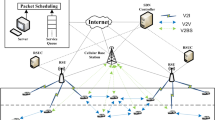Abstract
Neighborhood discovery is a fundamental link layer service for safety and non-safety applications in VANETs. Till now, this service is made available by beaconing. But, several studies demonstrate its inefficiency. In the literature, several papers propose adaptive strategies to alleviate the channel load problem, but packet loss due to collision remains an open issue due to the randomness of beacon sending through the network. In this paper, we propose an SDMA-based beaconing with load balancing method that distributes beacon sending load fairly. In the proposed scheme, the vehicles self-organize themselves into groups depending on their positions. Then, all beacons are sent sequentially along the period, thereby reducing the congestion. We drive extensive simulations to demonstrate the effectiveness of our strategy.









Similar content being viewed by others
References
Doukha Z, Moussaoui S (2015) An SDMA-based mechanism for accurate and efficient neighborhood discovery link layer service, IEEE Transactions on Vehicular Technology, No. 99
Hadded M, Zagrouba R, Laouiti A, Muhlethaler P, Saïdane LA (2014) An adaptive TDMA slot assignment strategy in vehicular ad hoc networks. J Mach Mach Commun 1:175–194
Ye F, Adams M, Roy S (2008) V2V wireless communication protocol for rear-end collision avoidance on highways. Communication Workshops ICC Workshops. IEEE International Conference, Beijing, pp 375–375
Booysen M, Zeadally S, van Rooyen GJ (2011) Survey of media access control protocols for vehicular ad hoc networks. Inst Eng Technol (IET) 5(11):1619–1631
Abdou W, Darties B, Mbarek N (2015) Priority levels based multi-hop broadcasting method for vehicular ad hoc networks. Ann Telecommun 70(7):359–368
Booysen M, Zeadally S, van Rooyen GJ (2012) Performance comparison of media access control protocols for vehicular ad hoc networks. Inst Eng Technol (IET) 1(1):1019
IEEE, IEEE Standard for Information technology–Telecommunications and information exchange between systems–Local and metropolitan area networks–Specific requirements Part 11: Wireless LAN Medium Access Control (MAC) and Physical Layer (PHY) Specifications, IEEE IEEE P802.11p-2010
Schmidt R, Leinmuller T, Schoch E, Kargl F (2010) Exploration of adaptive beaconing for efficient intervehicle safety communication. Netw, IEEE 24(1):14–19
Alvin S., Maolin T, Yanming F, Looi M (2012) Context aware rate adaptive beaconing for efficient and scalable vehicular safety communication. Int J Commun Netw Syst Sci 5(9):534–547
Ghafoor KZ, Bakar KA, van Eenennaam EM, Khokhar RH, Gonzalez AJ (2013) A fuzzy logic approach to beaconing for vehicular Ad hoc networks. Telecommun Syst 52(1):139–149. Oakland
Yang L, Guo J, Wu Y (2008) Channel adaptive one hop broadcasting for vanets. In: IEEE ITSC, pp. 369–374
Mittag J, Thomas F, Härri J, Hartenstein H (2009) A comparison of single- and multihop beaconing in VANETs, Proceedings of the 6th ACM international workshop on VehiculAr InterNETworking, PP. 69-78, New York, USA
Van Eenennaam EM, Karagiannis G, Heijenk G (2010) Towards scalable beaconing in VANETs. In: Proceedings of the 2010 ERCIM workshop on eMobility, pp 103–108, Lulea
Sadatpour V, Fathy M, Yousefi S, Rahmani AM, Cho E, Choi MK (2009) Scheduling algorithm for beacon safety message dissemination in vehicular Ad-Hoc networks. Commun Comput Inf Sci 56:133–140
Rawat DB, Popescu DC, Yan G, Olariu S (2011) Enhancing VANET performance by joint adaptation of transmission power and contention window size. IEEE Trans Parallel Distrib Syst 22(9):1528–1535
Yousefi S, Fathy M, Benslimane A (2007) Performance of beacon safety message dissemination in vehicular ad hoc networks (vanets). J Zhejiang Univ Sci A 8(12):1990–2004
Krajzewicz D, Erdmann J, Behrisch M., Bieker L (2012) Recent development and applications of SUMO simulation of urban MObility. Int J Adv Syst Measur 5(3&4):128–138
Samara G. Ramadas S, Al-Salihy WAH (2010) Safety Message Power Transmission Control for Vehicular Ad hoc Networks. J Comput Sci 6(10):1027–1032
Hrizi F, Bonnet C, Härri J, Filali F (2013) Adapting contention-based forwarding to urban vehicular topologies for active safety applications. Ann Telecommun 68(5):267–285
Ghafoor KZ, Lloret J, Bakar KA, Sadiq AS, Mussa SAB (2013) Beaconing approaches in vehicular Ad Hoc networks: A survey. J Wirel Pers Commun 73(3):885–912
Author information
Authors and Affiliations
Corresponding author
Rights and permissions
About this article
Cite this article
Doukha, Z., BenMussa, S.A., Ghafoor, K.Z. et al. Load balancing aware SDMA-based beaconing approach in vehicular ad hoc networks. Ann. Telecommun. 72, 189–197 (2017). https://doi.org/10.1007/s12243-017-0562-y
Received:
Accepted:
Published:
Issue Date:
DOI: https://doi.org/10.1007/s12243-017-0562-y




